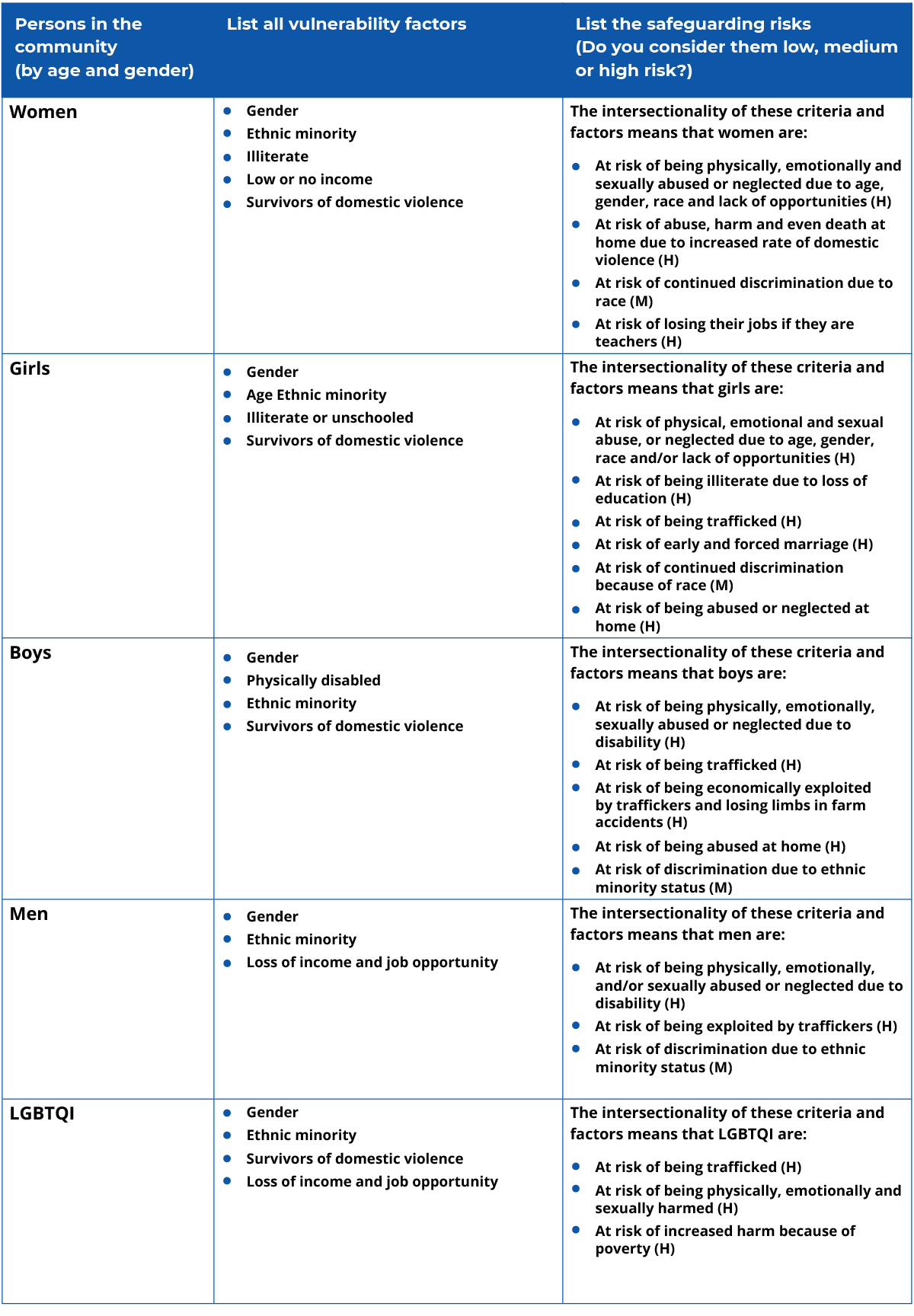Unit 2: Identification
| Site: | OpenLearn Create |
| Course: | Implementing Safeguarding in the International Aid Sector |
| Book: | Unit 2: Identification |
| Printed by: | Guest user |
| Date: | Tuesday, 25 November 2025, 3:11 PM |
Introduction

In Unit 1 you learnt that safeguarding is everyone’s responsibility, and we looked at the fundamentals of this concept. In this unit we focus on the ‘‘identification’ part of the safeguarding cycle.
It is important that you and your organisation’s staff who have direct or indirect contact with children or vulnerable adults are able to recognise factors which make individuals vulnerable to harm. This will equip you better to prevent exploitation, abuse and harassment, and be able to respond appropriately if it does happen.
To do so, we will be exploring the inherent (internal to the person) criteria that make a child or adult vulnerable to harm and those which are external to the person. These criteria or factors make children and adults vulnerable to various forms of harm including sexual exploitation, abuse and harassment (known as SEAH).
We will also look at how the intersectionality of internal and external criteria can increase the risk of vulnerability of children and adults, and therefore those of us who are aware of this increased vulnerability should ensure that we take measures to prevent the likelihood of harm occurring by using various tools such as a situational analysis and risk assessments.
In each unit of this course, we will apply our learning to certain types of programmatic activity to demonstrate how safeguarding principles can be implemented. In this unit we will apply our learning to research programmes, such as data collection, working safely with research participants, and the importance of safe programming.
We will look at tools that could support you to reflect on how to gauge risk and vulnerability when working with research participants on any given programme. There are also activities that will help you further understand your role and responsibility in safeguarding.
2.1 Identifying vulnerability and risk
Why does vulnerability and risk matter?

When organisations work in various activities and programmes, it’s important to ensure that we ‘do no harm’. Simply put, this means that we mitigate against any harm that may arise as a result of our activities and programmes.
Realistically, eradicating all harm is not possible, but we would want to ensure that we provide our services and support to communities safely, which includes, in so far as is possible, reducing the risk of any harm that may arise.
Therefore, safe programming includes:
- Identifying, mitigating and managing the risks of harm and abuse that may be caused by programme design and delivery.
- Considering the safety and wellbeing of all community members throughout the programme cycle.
- Being prepared not to deliver a programme where safeguarding risks have not been appropriately assessed and minimised and/or where the inherent risks to beneficiaries are unacceptable.
- Documenting safe programming experiences to inform future work.
(Source: RSH: How CSOs can Design and Deliver Safe Programmes)
You will be aware that you and your organisation have a duty to identify, prevent, report and respond to concerns that a child or adult may be suffering harm. This will include those your organisation works with (such as other staff or volunteers) or works for (children, communities and others who may benefit from the work).
Early recognition that an individual may be vulnerable to abuse or harm may prevent harm from occurring in the first place or prevent further harm from occurring. Recognising indicators of abuse may be challenging, but the ability to recognise signs and symptoms early is of fundamental importance.
It is also important to remember that children or vulnerable adults are put at risk by unsafe organisational practices and through the behaviour of people whom they know. If you want to understand more about SEAH please follow the link.
Factors that make children vulnerable

Factors that increase a child’s vulnerability to harm include:
- Age – babies are more vulnerable than older children.
- Trust – children are more trusting of adults who have direct contact with them. They may not understand what an appropriate or inappropriate touch is, their right to personal privacy or their right to express themselves.
- Disability – children who have a physical, mental or learning disability are more vulnerable than other children. They are in need of more personal or intimate care, which requires more direct contact. Their vulnerability may increase when they are in residential or institutional care.
- Other criteria such as being part of a marginalised group.
- Societal perceptions where children are often considered unimportant and unworthy of any rights of their own.
- Children who are orphaned due to parental loss or death due to disease.
- Children infected or affected by HIV/AIDS.
- Children born out of wedlock.
- Gender – often girls are more at risk of harm because of societal perceptions that they hold a lesser status than boys. However, in certain situations (such as armed conflict), boys may well be at greater risk of forced recruitment and sexual violence.
- Inability of parents or family to care for children because of their own inherent factors such as their young age, ignorance or lack of knowledge, traumatic childhood, isolation, substance misuse, mental illness, physical or learning disability.
- Violence or domestic abuse within the family or in the community.
- Environmental factors, such as natural disasters, armed conflict and pandemics, or a combination of all these factors that displace children and adults, making them vulnerable.
- Loss of name, nationality or migrant status which results in a lack of political or civil status.
- Low economic or social status.
As workers who have either direct or indirect contact with children and/or vulnerable adults, we not only need to be able to recognise vulnerability factors, but also that these factors increase their risk of harm by perpetrators who misuse their power to exploit, abuse and/or harass children.
|
Activity 2.1 Organisational factors What organisational factors may make a child vulnerable to exploitation and abuse? Record your response in your learning journal. |
Factors that make adults vulnerable to harm
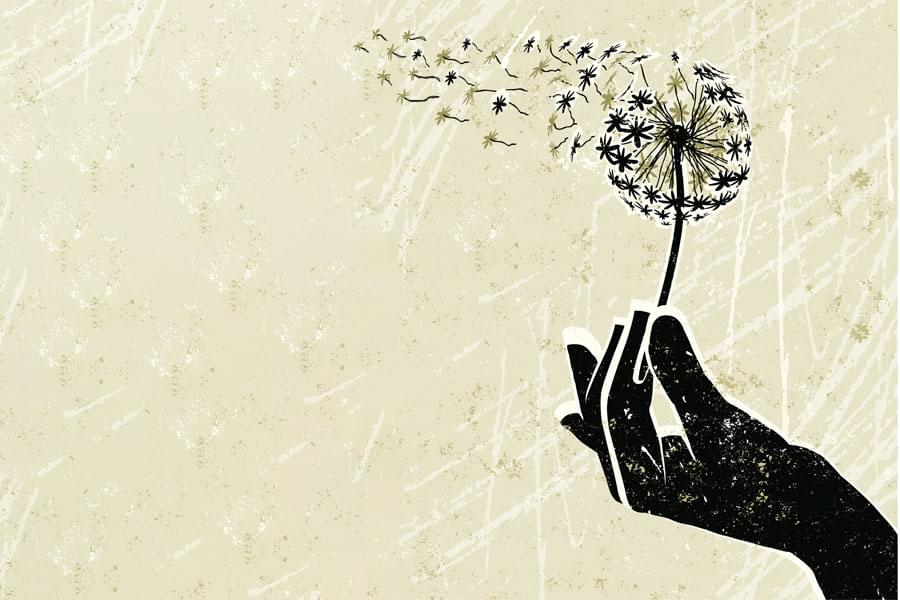
© MHJ / Getty Images
An adult who is experiencing, or is at risk of experiencing harm, abuse or exploitation and who is unable to protect themselves against harm is known as a ‘vulnerable adult’ or an ‘adult at risk’ (of harm).
Such adults may be dependent on others to meet their physical, emotional and material needs. These adults are at a higher risk of exploitation, abuse and harassment, and their vulnerability increases with a combination of several of these factors:
- Age – older people may be more vulnerable to abuse because of poor physical or mental health or reliance or support from others for daily activities.
- Disability – adults who have a physical, mental or learning disability are more vulnerable to exploitation and harm. They may need personal or intimate care, which often requires more direct bodily contact with others. Vulnerability may increase when they are in residential or institutional care. Adults with disabilities may also be more vulnerable to abuse because they may be less valued in their communities or have less understanding of their rights.
- Sex and sexuality – people who are or identify themselves as lesbian, gay, bisexual, transgender, queer or intersex (known as ‘LGBTQI+’) or non-binary are often vulnerable because of societal perceptions and discrimination against such groups.
- Ethnicity – usually those who identify as part of a minority racial group are vulnerable to abuse because of oppression and discrimination.
- Literacy – generally adults who are unable to read or write because of a lack of educational opportunities are more at risk of exploitation and harm.
- Gender – women are more at risk of harm because societal perceptions accord them a lesser status than men. However, in situations of armed conflict men may be more vulnerable.
- Loss of home, family members and/or financial and material support.
- Inability of family to care for older people leading to harm or neglect because of a lack of ability or ignorance.
- Displacement because of natural disasters, armed conflict, pandemics or a combination of all these factors.
- Loss of name, nationality or migrant status which means no political or civil status.
- Poverty or low economic status.
|
Activity 2.2 The same of different? Children and adults vulnerability. Consider the following question and record your response in your learning journal:
|
2.2 Gender and Intersectionality in safeguarding
Gender plays a significant role in safeguarding, with differing groups in differing contexts having an important impact on identifying risks. We explore the role of gender and the considerations that need to be accounted for.
What role does ‘gender’ play?
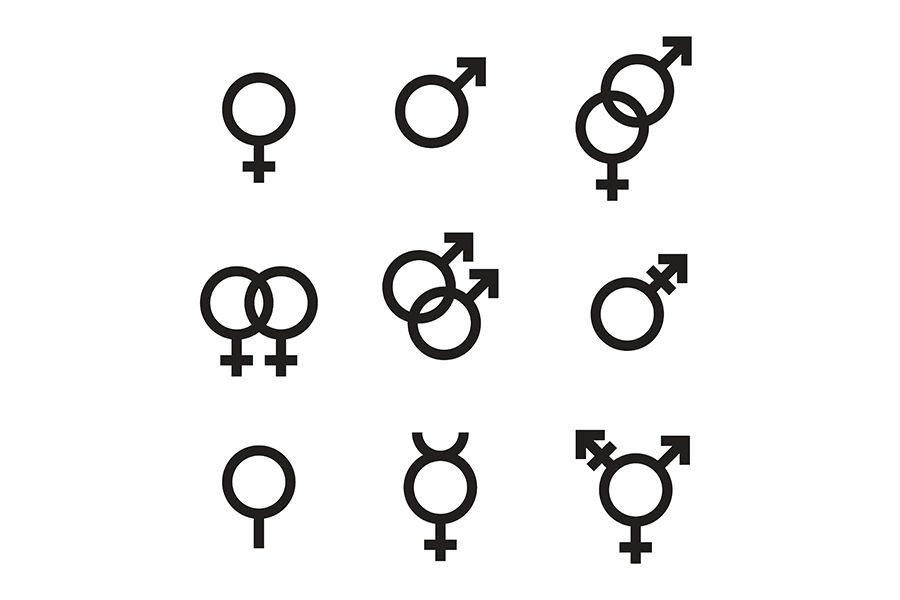
The term ‘gender’ is used to refer to the societal perceptions of the roles men and women play in society. It is not about the biological make-up of a man or a woman (which is known as ‘sex’). People sometimes believe that what constitutes a man being ‘masculine’ or a woman ‘feminine’ are grounded in biology, but actually they are learnt through socialisation.
Societal perceptions of the role of a man and a woman often underpin power differentials and inequality which could make girls and women more vulnerable to SEAH. SEAH occurs because of inherent power inequalities and differentials in the aid sector.
Using a ‘safeguarding lens’ (think of this as putting on spectacles) when working with beneficiary communities, alerts us to the importance of identifying, preventing and responding to the diversity of ways that men, women, boys and girls might be made vulnerable to being harmed, particularly to SEAH.
|
Activity 2.3 Gender and safeguarding Why is gender an important factor when thinking about safeguarding? Record your response in your learning journal. |
What is intersectionality?
![]()
Reference: Crenshaw K (1989)
In some cases, a child or an adult could have a combination of inherent factors which make them vulnerable.
We call this ‘intersectionality’ – the overlapping or intersecting of identities and the experiences of oppression and discrimination of men, women, boys and girls. Intersectionality recognises not only differences between identities (such as race, gender, and gender identities), but also differences within these identities.
For example, the experiences of women of an ethnic minority will often be different to women who are from an ethnic majority group. Where the interconnected nature of social categories such as race, class, and gender apply to a given individual or group, it creates an overlapping interdependent system of discrimination or disadvantage that leaves a child or adult vulnerable to the risk of greater harm.
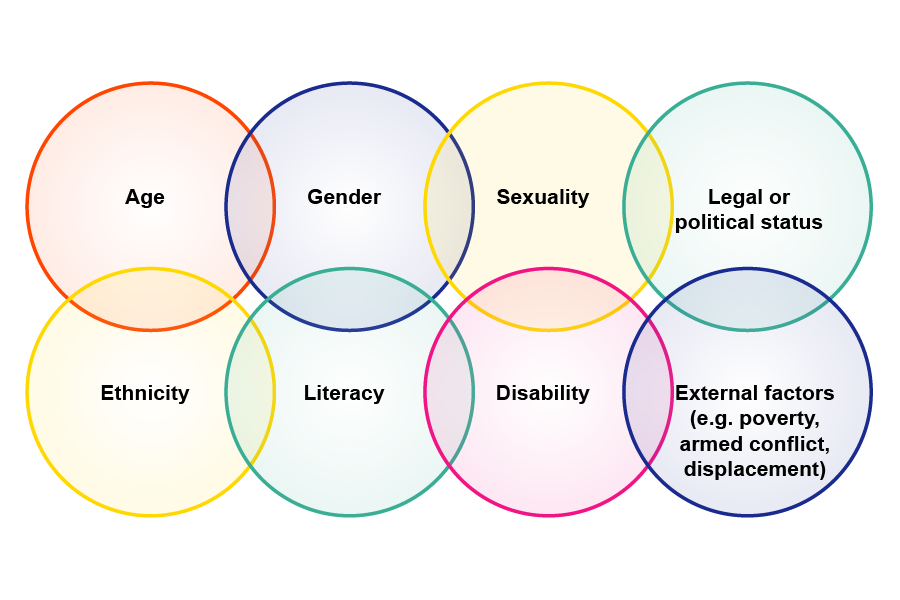
|
Activity 2.4 Using intersectionality Consider the following two questions and record your response in your learning journal:
|
2.3 Safeguarding in research
Organisations working in the international aid sector often undertake research. This section covers how principles governing research and data collection can be applied with a focus on safeguarding.

When we undertake activities and programmes with communities, we should be aware of their vulnerabilities (and the intersectionality of factors) and ensure that we do not increase the risk of harm.
For example, if you work in data collection, monitoring or research it’s important to identify community vulnerabilities so that appropriate safeguarding measures can be put in place prior to and during any activity.
|
Activity 2.5 Case Study Let’s apply what we have learnt so far on vulnerability and risk of harm using the case study below:
Note some ideas in your learning journal. ABC University has obtained donor funding to undertake research in a rural, farming community in District D. The objective of the research is to gauge how the recent drought in the area has affected the lives of women and children of this community made up of a minority ethnic group with a low literacy rate. Since the drought, the farmers have lost their livestock and income. There has been a spike in domestic violence in family homes. Teachers have not been paid for several months and have stopped working. Traffickers have started roaming the area, enticing parents to give them their children for a “better life”. Instead, children are being trafficked to neighbouring countries to be married or to beg on the streets to support family incomes. There is anecdotal information that some of the boys have lost limbs due to accidents when illegally working on farms. The research team will be made up of local data collectors. The results of the research will help address some of these problems in this community. |
Research ethics and safeguarding
When undertaking research, academic institutions, consulting firms and data collectors may typically use ethical research principles to guide them.
These ethical principles may include:
- Research which should aim to maximise the benefits for individuals and society and minimise risk and harm.
- A clause or standard to ensure that the rights and dignity of individuals and groups are always respected.
- Wherever possible, that participation should be voluntary and appropriately informed (i.e. informed consent and in accordance with data protection laws).
- A clause or standard to ensure that research is conducted with integrity and transparency at all times.
- Lines of responsibility and accountability which should be clearly defined.
- Independence of research which should be maintained and, where conflicts of interest cannot be avoided, such conflicts should be made explicit.
(Source: Our core principles - Economic and Social Research Council (ukri.org))
These important ethical principles could be expanded further using a safeguarding lens.
For example, we should incorporate safeguarding principles into the project design from the outset by identifying the vulnerability of research participants, the potential of increasing risk of harm to them when undertaking research, and the obvious power differential that exists between a researcher and research participant.
If you want to find out more about safeguarding in research, follow the links below:
- Safeguarding in International Development Research: A Briefing Paper (PDF) University of Sussex
- How can we ethically involve children in research? ECPAT
- Research Integrity UKRI
Incorporating safeguarding principles in the research
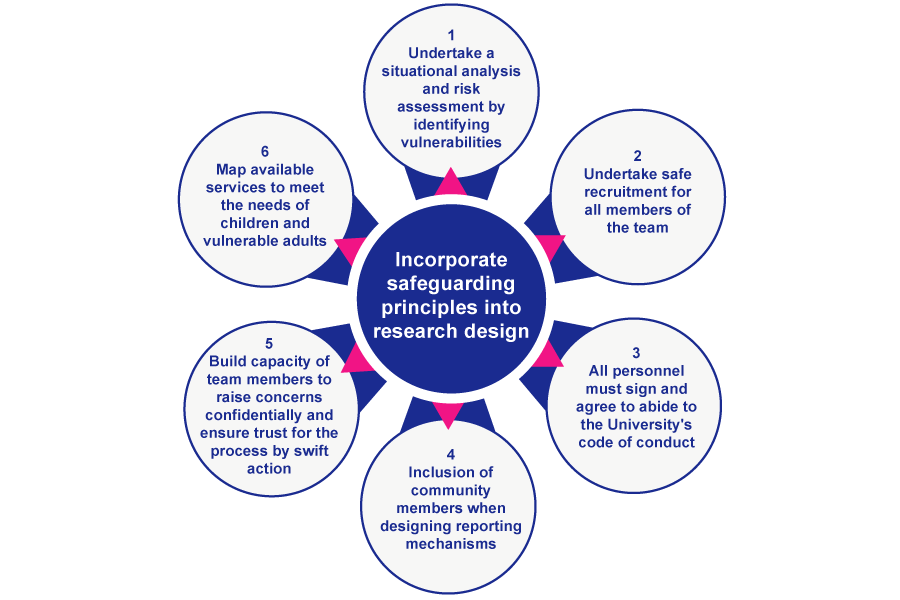
The team at the University in the case study should incorporate safeguarding principles into their research design right from the beginning, since any form of data collection for the purpose of research is not without risk. This is because asking research questions may lead to the re-traumatisation of the interviewees and / or make him/her/them more fragile and vulnerable. Some research programmes offer incentives for participation, and this can be manipulated to the disadvantage of the interviewee. It is important to identify safeguarding risks in undertaking research because of the potential contact with vulnerable populations and the likelihood of abuse given the asymmetric relations between the researcher and the population to be researched.
Researchers should make ethical decisions by identifying vulnerabilities of and risks to research participants and put in place reasonable steps to minimise and mitigate these, ensuring that the best interests of the research participant are central.
Using the project cycle management model of Identify, Design, Implement, Monitor and Learn, the diagram above illustrates some of the steps to take by those who conduct data collection for research in order to mitigate and minimise risks using a safeguarding lens.
2.4 Assessing risk; conducting a situational analysis.
We have covered a number of different factors that affect ‘risk’ and how it is perceived. Here we discuss the methodologies that can be used to effectively conduct a formal assessment of these risks.

Staying with the case study of ABC University, undertaking a ‘situational analysis’ can help to understand the context that the research team will be working in.
We already know that the external factors of drought and displacement have made all community members vulnerable. Using this as a backdrop, we then take a gendered approach to highlight specific vulnerabilities.
|
Activity 2.6 Situational analysis template Allow 30 minutes Complete the blank situational analysis template for the case study of ABC University. Here is a writable version of this situational analysis template shown below. You can type into this PDF form and then save it and/or print it.
An example of a completed situational analysis is shown below for comparison. Situational analysis – context: A displaced community due to drought
Here is a PDF version of this model situational analysis shown above. You can learn more about undertaking a situational analysis by following the link below:
|
Risk Assessments
We should also develop a safeguarding risk assessment based on the situational analysis. You may remember that we learnt about such risk assessments in Course 1: Introduction to Safeguarding in the International Aid Sector.
Still using the example of the ABC University research case study, let’s go through three quiz questions so that you can try and recall how to undertake a safeguarding risk assessment exercise.
|
Activity 2.7 Identifying risks (Quiz) Quiz rules Quizzes within the learning content do not count towards achieving your Digital Badge/Statement of Participation. Only the quiz at the end of each unit counts towards achieving your Statement of Participation. You may take as many attempts as you wish to answer the quiz. You can skip questions and come back to them later if you wish. |
How to undertake a risk assessment
![]()
As a reminder on how to undertake a safeguarding risk assessment watch the video above.
Developing a risk assessment
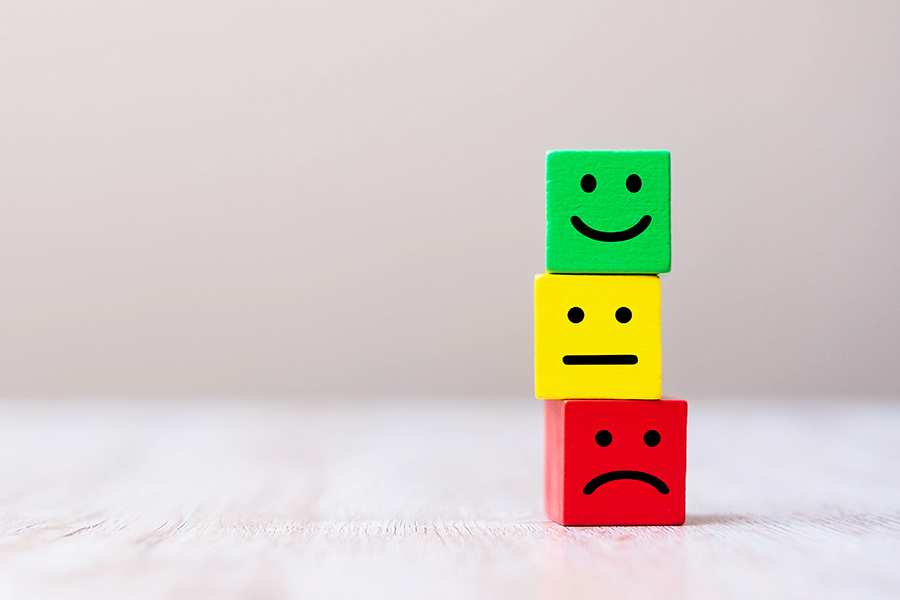
© Panuwat Dangsungnoen / iStock / Getty Images Plus
When undertaking a risk assessment for the research project being conducted by ABC University, here are some key points to think about:
- A risk assessment should be carried out with input from local collaborative partners and community members so that external risks and vulnerabilities are also taken into consideration.
- A risk assessment must identify and record all risks of intended or unintended harm. It should not only consider risks to research participants, but also risks to researchers.
- Mitigation safeguarding measures should be proposed and put in place.
- A risk analysis must differentiate between short-term risks (for example, immediate dangers that could arise during the fieldwork) and long-term risks (for example, participants’ future eligibility to access benefits when a programme is implemented).
- A risk analysis should include considerations on how to ensure participants’ confidentiality for safety or legal reasons and put in place a protocol for this.
- The names and contact details of both the research team and the safeguarding focal points should be clearly stated in the risk analysis.
- The risk analysis should be signed off by team leaders and the Safeguarding Lead.
A risk assessment should be continuously updated throughout the course of a research project. If it emerges that the research carries a higher risk for any one group or person than was initially thought, then it should be redesigned to address and reduce those risks. If this is not possible, the research cannot go ahead.
|
Activity 2.8 Developing mitigating safeguarding measures Return to the case study of ABC University and reflect on the following:
|
If you want to learn more about risk assessment have a look at the following links:
- Safeguarding risk assessment and management tool (PDF) Safeguarding Resource and Support Hub
- Research Ethics: A practical guide Oxfam GB
- Addressing Safeguarding Risks Safeguarding Resource & Support Hub
2.5 Lessons learnt when incorporating safeguarding measures
This section considers the lessons to be learnt, and what else you should think about when incorporating safeguarding measures.
![]()
Watch the video above, in which the presenter shares what lessons were learnt when safeguarding measures were incorporated into the ARISE research project in Sierra Leone.
What else should you think about?

When collecting data from local communities you should consider everything outlined in the diagram below.
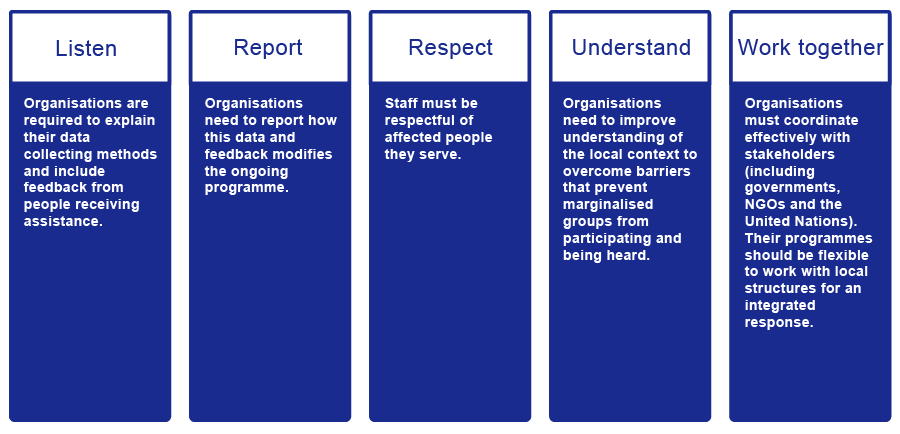
Some of the key points from the video on conducting research are that it presented a bottom-up approach rather than top-down approach by empowering community members to get involved in conducting the research. Community members were involved in contextualising safeguarding training using local terminology and creating safeguarding systems. The development of a service directory through service mapping is particularly important so that communities know where to go for services when the implementing organisation isn’t there.
If you want to know more about safeguarding in research, go to the following links:
- Research: Let’s make it safe! Resource & Support Hub (RSH)
- Empowered Aid: Toolkit for planning safer aid distribution (PDF) Global Women’s Institute
- Taken out of the picture: The researcher from the Global South and the fight against ‘neo-colonialism’ Governance in Conflict Network
Safeguarding principles pertaining to research

The UKCDR Guidance on Safeguarding in International Development Research (PDF) is useful for promoting safeguarding issues in any organisation conducting data collection for reports or research.
It sets out four cross-cutting themes and provides questions relating to safeguarding for all involved in the activity. It makes the point that simply laying down a fixed set of requirements is impractical and could potentially reinforce power dynamics. Instead it promotes posing key questions and generating discussion as a more productive way forward for all involved in the research processes in order to ‘anticipate, mitigate and address potential and actual harms in the funding, design, delivery and dissemination of research’.
|
Activity 2.9 Quiz - Safeguarding principles in research Read pages 1-9 of the Guidance on Safeguarding in International Development Research and then attempt the four quiz questions that follow. Quiz rules Quizzes within the learning content do not count towards achieving your Digital Badge/Statement of Participation. Only the quiz at the end of each unit counts towards achieving your Statement of Participation. You may take as many attempts as you wish to answer the quiz. You can skip questions and come back to them later if you wish. |
A question about recruitment
![]()
Hasan, a Human Resources Manager based in Amman, has a question about recruitment.
Watch the video above to learn more about Hasan’s question and the response he is given.
Greater diversity and inclusion in your recruitment processes keeps people safe because it fosters trust and accountability. A more diverse and inclusive workforce makes for more effective teams.
2.6 Unit 2 Knowledge check (Quiz)
The end-of-unit knowledge check is a great way to check your understanding of what you have learnt.
There are five questions, and you can have up to 3 attempts at each question depending on the question type. The quizzes at the end of each unit count towards achieving your Digital Badge for the course. You must score at least 80% in each quiz to achieve the Statement of Participation and Digital Badge.
2.7 Review of Unit 2

© Feodora Chiosea / iStock / Getty Images Plus.
In this unit we focused on the first part of the safeguarding cycle – ‘Identification’.
We looked at identifying what criteria and factors make children and adults vulnerable to various forms of harm including sexual exploitation, abuse and harassment (SEAH). We also looked at the intersectionality of various factors and how that increased risk of harm. We applied our learning to a case study on undertaking research on research participants.
We went through various tools with regards to how to conduct research in a safe way, applying safeguarding and ethical principles such as a situational analysis to highlight vulnerability and risks, and a risk assessment to think through safeguarding measures which would minimise risk of unintended harm from occurring.
Finally, we examined the most up-to-date UKCDR guidance on how to conduct research where everyone has a responsibility to play.
|
Before you move on to Unit 3, reflect on your own learning so far. Consider the following questions and respond to the questions in your learning journal.
|
Now go to Unit 3: Prevention.
References
Crenshaw K (1989) Demarginalizing the Intersection of Race and Sex: A Black Feminist Critique of Anti-discrimination Doctrine, Feminist Theory and Antiracist Politics. University of Chicago Legal Forum Volume 1989 | Issue 1
Safeguarding Support Hub (2021) ‘How CSOs can Design and Deliver Safe Programmes’, How-To-Note, Online. Available at Resource and Support Hub (Accessed 21 June 2021).
UK Collaborative on Development Research (UKCDR) (n.d.) Guidance on Safeguarding in International Development Research, Online. Available at UKCDR (PDF) (Accessed 23 June 2021).
UK Research and Innovation (2021) Framework for research ethics, Online. Available at UKRI (Accessed 28 June 2021).

